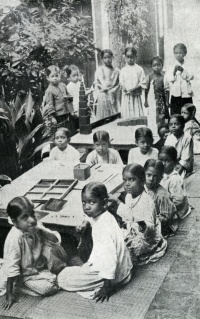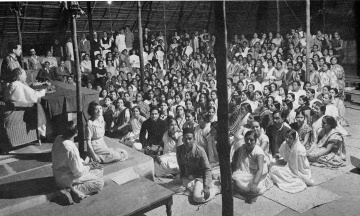Maria Montessori
ARTICLE UNDER CONSTRUCTION
ARTICLE UNDER CONSTRUCTION
Dr. Maria Montessori was an Italian physician who developed ground-breaking methods for teaching children. For ten years she was a guest at the headquarters of the Theosophical Society based in Adyar, India, along with her son Mario. During that period she conducted courses for teachers all over South Asia, which has had a lasting impact on education there.
Life
Maria Montessori was born on August 31, 1870, in the provincial town of Chiaravalle, Italy. Her father was a financial manager for a state-run industry. With the support of her well-educated mother, Maria grew up with a love of learning.[1] In 1883, when she was just thirteen, Maria was admitted to the Regia Scuola Tecnica Michelangelo Buonarroti. Few girls entered such technical schools, with more opting to study classics instead.
The technical system provided seven years of a modern curriculum. These schools offered a three-year course including French, arithmetic and bookkeeping, algebra and geometry, history, geography, and smattering of science. This was followed by the four-year course at the technical institute which offered modern languages - French, German, English - and mathematics, in addition to commercial subjects. Physics and chemistry were included but occupied a less important place in the curriculum.[2]
After completing this technical education with high scores, Montessori considered becoming an engineer, but decided instead to study medicine, which no Italian woman had done before. She enrolled in the University of Rome in the fall of 1890, and studied mathematics and sciences, Latin and Italian. In the spring of 1892 she passed her examinations and received the "Diploma di licenza" that indicated she was qualified to study medicine. After many obstacles, and with her mother's support, she was permitted to begin the program consisting of six years of study and clinical work.[3] Despite many obstacles, including her father's disapproval, she succeeded in becoming a physician in 1896.[4]
Medical career
First House of Children
The first Casa dei Bambini (House of Children) was opened in Rome in 1907, after a group of bankers asked Dr. Montessori to find a way to occupy the children of poor families in a San Lorenzo tenement. Her acclaimed success led to the rapid expansion of the Montessori Method throughout the world.
Theories about childhood development
First House of Children
The first Casa dei Bambini (House of Children) was opened in Rome in 1907, after a group of bankers asked Dr. Montessori to find a way to occupy the children of poor families in a San Lorenzo tenement. Her acclaimed success led to the rapid expansion of the Montessori Method throughout the world.
Teaching method
These are features of her educational approach:
- Fantasy is postponed until the child is grounded in reality.
- Tasks and activities are reality oriented.
- Manipulative materials are designed to be aesthetically pleasing, and to support very specific educational goals.
- The intellect or "absorbent mind" is engaged early, and is challenged more over time.
- Children are free to choose their own activities in the classroom, and individual choices are respected.
- The atmosphere is calm and productive.
- Teacher is a facilitator of independent learning.
- Multi-age groups in classrooms simulate the reality of families.
- Socialization begins with respecting the independence and space of other children.
- Older children voluntarily assist each other in learning.
- Children are grounded in the realities of the formed world before delving into the spiritual realm.
Involvement with Theosophists
Dr. Montessori "went to hear Annie Besant speak in London in 1907 after Montessori had established her first Casa dei Bambini (Children’s House). Annie Besant spoke in praise of Montessori’s work in education which pleased Montessori, and thus sealed their friendship."[5] They "formed a friendly relationship that was renewed whenever Dr. Besant came to Rome in the years before World War I ."[6] Theosophists paid attention to the Montessori educational system, and were writing articles about her methods in 1913. Society members established many schools in India and Sri Lanka, and experimented with various methods to find what would work best under local conditions. Examples are night schools and elementary classes taught by college students. National Hindu Girls’ School in Madras, had a Montessori class operating by 1918, as shown in the photograph at right. At that point the school was under the supervision of the Society for the Promotion of National Education.
Teaching in India, 1939-1949
The international President of the Theosophical Society based in Adyar, India, Dr. George S. Arundale, and his wife, the famous Indian dancer Rukmini Devi Arundale, spent time in The Netherlands, visiting the International Theosophical Centre at Naarden. Both Arundales were intensely interested in children and in education. They met Dr. Montessori and invited her to come to Society headquarters in Adyar, Chennai (then called Madras) to conduct a teaching course. She flew to India in 1939 and was warmly received. About 300 teachers from all over India attended.
Due to her Italian citizenship, in the early days of World War II Dr. Montessori was interned by the British authorities, restricted by house arrest to the Adyar headquarters estate. She and her son Mario were released from detention, and conducted teachers' courses in Ahmedamad, Kodaikanal, Adyar, and Kashmir in India, and also in Ceylon. Adyar remained her base of operation until 1946. Then she traveled to England and Scotland, and to Italy, but returned to India late in 1947 to teach in Poona, Gwalior, and Adyar. "With Mrs. Arundale, she established a Montessori training center at Kalakshetra as a memorial to Dr. Arundale, who had died in 1945.[7] In 1949, she also taught in Pakistan at the invitation of the new government. After that she re-established her base of operation in The Netherlands. [8]
Theosophical publications
Both Dr. Montessori and her son Mario wrote articles for The Theosophist, the Society’s journal. For a list of articles by and about Dr. Montessori in Theosophical periodicals, see this list.
Additional resources - general
- Kramer, Rita. Maria Montessori: A Biography. Chicago: University of Chicago Press, 1976.
- Standing, E. M. Maria Montessori: Her Life and Work. New York: Penguin Group, 1998. Originally published in 1957.
Additional resources - Montessori and Theosophical Society
- Jinarajadasa, C. "The Montessori Gospel of the Child." The Theosophist 67 (May, 1946), 91.
- Jinarajadasa, C. "The Montessori Method." Theosophy in Australasia' 22.2 (May, 1916), 43.
- Jinarajadasa, C. "The Montessori System." The Theosophist 62 (April, 1941), 35.
- Jinarajadasa, C. "The Montessori System." Theosophy in Australia2 (February, 1942), 5.
- Ransom, Josephine. "Schools of Tomorrow in England: The Montessori Ideal.' 'The Herald of the Star 7 (August, 1918), 439.
- Wylie, Winifred. "Montessori and the Theosophical Society." Quest 96.2 (March-April, 2008), 53-55. Available at Quest magazine.
Notes
- ↑ "Maria Montessori," American Montessori Society web page.
- ↑ Rita Kramer, Maria Montessori: A Biography, (Chicago: University of Chicago Press, 1976), 32.
- ↑ Rita Kramer, Maria Montessori: A Biography, (Chicago: University of Chicago Press, 1976), 34-35.
- ↑ E. M. Standing, Maria Montessori: Her Life and Work, (New York: Penguin Group, 1998) 27.
- ↑ Winifred Wylie, "Montessori and the Theosophical Society" Quest 96.2 (March-April 2008): 53-55.
- ↑ Rita Kramer. Maria Montessori: A Biography (Da Capo Press, 1988), 342.
- ↑ Rita Kramer. Maria Montessori: A Biography (Da Capo Press, 1988), 355.
- ↑ E. M. Standing, Maria Montessori: Her Life and Work (Fresno, CA: Academy Library Guild, 1959), 50-51.

